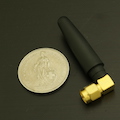The Yocto-Color and RGBW leds
![]() The Yocto-Color-V2 was designed in the beginning of 2016 to drive those small RGB leds that one can wire serially and address individually, the most well known ones being the Adafruit NEOPIXEL leds. Meanwhile appeared the RGBW leds, which can emit not only red, green, and blue but also white and which are, for sure, compatible with the classic RGB leds. Good news: we just published a new firmware for the Yocto-Color-V2 which drives these RGBW leds.
The Yocto-Color-V2 was designed in the beginning of 2016 to drive those small RGB leds that one can wire serially and address individually, the most well known ones being the Adafruit NEOPIXEL leds. Meanwhile appeared the RGBW leds, which can emit not only red, green, and blue but also white and which are, for sure, compatible with the classic RGB leds. Good news: we just published a new firmware for the Yocto-Color-V2 which drives these RGBW leds.
| No comment yet | Read more... |
New: PRTG support in the YoctoHubs
![]() This week, we added support to the YoctoHubs and VirtualHub for a new monitoring and graph system, which is of particular interest to system engineers: PRTG. From now on, no more excuse for not detecting air conditioning failures before the servers crash :-)
This week, we added support to the YoctoHubs and VirtualHub for a new monitoring and graph system, which is of particular interest to system engineers: PRTG. From now on, no more excuse for not detecting air conditioning failures before the servers crash :-)
| No comment yet | Read more... |
Implementing a scale with Windows 10 IoT
![]() This week, we wanted to test Windows IoT. To do so, we decided to use a Raspberry Pi 3, our new Yocto-Bridge module and a Yocto-MaxiDisplay to implement a weighing scale.
This week, we wanted to test Windows IoT. To do so, we decided to use a Raspberry Pi 3, our new Yocto-Bridge module and a Yocto-MaxiDisplay to implement a weighing scale.
| No comment yet | Read more... |
New: alarms in Yocto-Visualisation app
![]() Someone recently asked us whether it was possible to add alarms in the Yocto-Visualization application. That's now done. Let's see how it works...
Someone recently asked us whether it was possible to add alarms in the Yocto-Visualization application. That's now done. Let's see how it works...
| No comment yet | Read more... |
GSM data usage for sensor monitoring
 A large portion of the costs for a remote monitoring installation using the cellular network is linked to communication costs that the provider bills. It is therefore important to correctly estimate the amount of data transmitted in order to budget the system, to select the most appropriate subscription, and make the best technical choices. Here are a few elements which can help you to do so.
A large portion of the costs for a remote monitoring installation using the cellular network is linked to communication costs that the provider bills. It is therefore important to correctly estimate the amount of data transmitted in order to budget the system, to select the most appropriate subscription, and make the best technical choices. Here are a few elements which can help you to do so.
| No comment yet | Read more... |
1 ... 10 ... 20 ... 30 ... 40 ... 50 ... 60 ... 70 ... 76 77 78 79 80 81 82 83 84 85 86 ... 90 ... 100 ... 110 ... 120 ... 130 ... 140 ... 150


